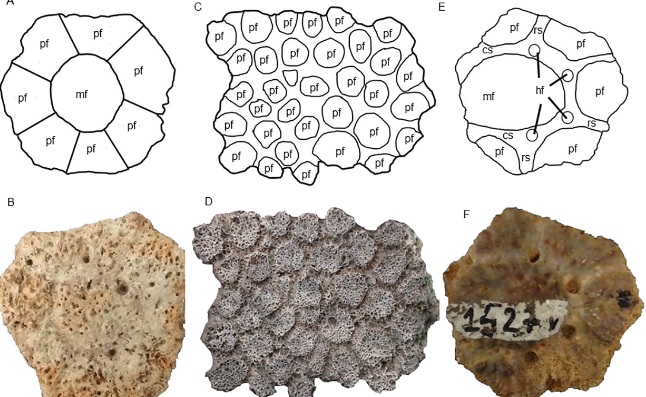@WFS,World Fossil Society,Riffin T Sajeev,Russel T Sajeev
Ectoparasitism and infections in the exoskeletons of large fossil cingulates

Schematic ilustration and terminologies for the external surface ornamentation of the osteoderms.
(A) and (B), Glyptotherium sp. (C) and (D), Panochthus sp.; (E) and (F), Pachyarmatherium brasiliense. mf: main figure; pf: peripheral figure; cs: central sulcus; rs: radial sulcus; hf: hair follicle. Scale bars: A = 5 cm; B = 4 cm and C = 3 cm.
Studies on paleopathological alterations in fossil vertebrates, including damages caused by infections and ectoparasites, are important because they are potential sources of paleoecological information. Analyzing exoskeleton material (isolated osteoderms, carapace and caudal tube fragments) from fossil cingulates of the Brazilian Quaternary Megafauna, we identified damages that were attributed to attacks by fleas and dermic infections. The former were compatible with alterations produced by one species of flea of the genus Tunga, which generates well-delimited circular perforations with a patterned distribution along the carapace; the latter were attributable to pathogenic microorganisms, likely bacteria or fungi that removed the ornamentation of osteoderms and, in certain cases, generated craters or pittings. Certain bone alterations observed in this study represent the first record of flea attack and pitting in two species of large glyptodonts (Panochthus and Glyptotherium) and in a non-glyptodontid large cingulate (Pachyarmatherium) from the Quaternary of the Brazilian Intertropical Region. These new occurrences widen the geographic distribution of those diseases during the Cenozoic and provide more evidence for the co-evolutionary interaction between cingulates and parasites registered to date only for a small number of other extinct and extant species.
Citation: de Lima FCG, Porpino KdO (2018) Ectoparasitism and infections in the exoskeletons of large fossil cingulates. PLoS ONE 13(10): e0205656. https://doi.org/10.1371/journal.pone.0205656
Editor: Dominique Heymann, Universite de Nantes, FRANCE
@WFS,World Fossil Society,Riffin T Sajeev,Russel T Sajeev



 May 31st, 2020
May 31st, 2020  Riffin
Riffin  Posted in
Posted in  Tags:
Tags: 